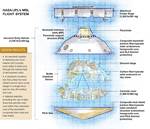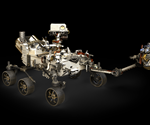Lockheed Martin delivers Mars 2020 rover aeroshell to launch site
The composite aeroshell for the Mars 2020 rover is, along with the Curiosity rover, the largest built.

Source | Lockheed Martin
The capsule-shaped aeroshell that will protect NASA's Mars 2020 rover was delivered to NASA's Kennedy Space Center in Florida on Dec. 13. Built by Lockheed Martin (Littleton, Colo., U.S.), the aeroshell will encapsulate and protect the Mars 2020 rover during its deep space cruise to Mars, and from the intense heat as the entry system descends through the Martian atmosphere to the surface of Mars.
Because of the large mass and unique entry trajectory profile that could create external temperatures up to 3,800°F (2,093°C), the heat shield uses a tiled Phenolic Impregnated Carbon Ablator (PICA) thermal protection system instead of the Mars heritage Super Lightweight Ablator (SLA) 561V.
This will be the second time PICA has flown on a Mars mission. The first was the Curiosity rover launched in 2011. See CW’s coverage of composites’ role in Curiosity’s design.
“Even though we have the experience of building the nearly identical aeroshell for the Curiosity rover, the almost 15-foot diameter composite structure was just as big a challenge to build and test 10 years later,” says Neil Tice, Mars 2020 aeroshell program manager at Lockheed Martin Space. “We've built every Mars aeroshell entry system for NASA of its 40 years of exploring Mars, so we pulled from that experience to build this important system.”
According to Lockheed Martin, along with the Curiosity mission, this is the largest aeroshell/heat shield ever built for a planetary mission at 4.5 meters (nearly 15 feet) in diameter. In contrast, the aeroshell/heat shield of the InSight lander measured 8.6 feet and Apollo capsule heat shields measured just less than 13 feet.
The backshell and heat shield were transported from Lockheed Martin's Waterton facility in Littleton, Colorado where they were built, to nearby Buckley Air Force Base. They were then loaded onto an Air Force transport plane and flown to NASA's Kennedy Space Center.
Recently, Lockheed Martin integrated the MSL Entry Descent and Landing Instrument (MEDLI2) onto the heat shield and backshell. Provided by NASA's Langley and Ames Research Centers, MEDLI2 will collect temperature and pressure data during the spacecraft's descent through the Martian atmosphere.
The Mars 2020 rover is in testing at NASA's Jet Propulsion Laboratory, Pasadena, Calif., U.S., which manages the Mars 2020 project for the NASA Science Mission Directorate. The mission will launch in July 2020 and land on Mars in February 2021 at the Jezero Crater.
Related Content
-
A new era for ceramic matrix composites
CMC is expanding, with new fiber production in Europe, faster processes and higher temperature materials enabling applications for industry, hypersonics and New Space.
-
Plant tour: Albany Engineered Composites, Rochester, N.H., U.S.
Efficient, high-quality, well-controlled composites manufacturing at volume is the mantra for this 3D weaving specialist.
-
Next-generation airship design enabled by modern composites
LTA Research’s proof-of-concept Pathfinder 1 modernizes a fully rigid airship design with a largely carbon fiber composite frame. R&D has already begun on higher volume, more automated manufacturing for the future.

.jpg;width=70;height=70;mode=crop)














